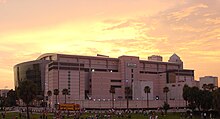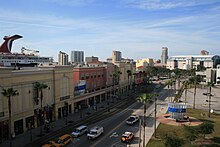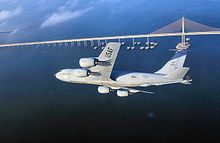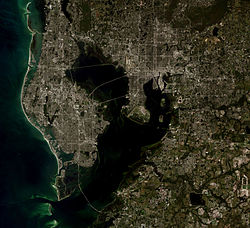Lowry Park Zoo features over 2,000 animals, interactive exhibits, rides, educational shows and more. The zoo serves as an economic, cultural, environmental and educational anchor in Tampa.
Big Cat Rescue is one of the largest accredited sanctuaries in the world dedicated entirely to abused and abandoned big cats.[121] It is home to about 80 lions, tigers, bobcats, cougars and other species, most of whom have been abandoned, abused, orphaned, saved from being turned into fur coats, or retired from performing acts.[121] They have a variety of different tours available.[122]
Busch Gardens Tampa Bay is a 335-acre (1.36 km2) Africa-themed park located near the University of South Florida. It features many thrilling roller coasters, for which it is known, including Sheikra, Montu, Gwazi and Kumba. Visitors can also view and interact with a number of African wildlife. Adventure Island is a 30-acre (12 ha) water park adjacent to Busch Gardens.
The Florida Aquarium is a 250,000 sq ft (23,000 m2) aquarium located in the Channel District. It hosts over 20,000 species of aquatic plants and animals. It is known for its unique glass architecture. Adjacent to the Aquarium is the SS American Victory, a World War II Victory ship preserved as a museum ship.
The Tampa Bay History Center is a museum located in the Channel District. It boasts over 60,000 sq ft (5,600 m2) of exhibits through 12,000 years. Theaters, map gallery, research center and museum store.
Well-known shopping areas include International Plaza and Bay Street, WestShore Plaza, SoHo district, and Hyde Park Village.[123] Palma Ceia is also home to a shopping district, called Palma Ceia Design District.[124] Previously, Tampa had also been home to the Floriland Mall (now an office park), Tampa Bay Center (demolished and replaced with the new Tampa Bay Buccaneers training facility, known as "One Buc Place"), and East Lake Square Mall (now an office park).
The Tampa Port Authority currently operates three cruise ship terminals in Tampa's Channel District. The Port of Tampa is the year-round home port for Carnival Cruise Lines' MS Carnival Inspiration and MS Carnival Legend. In 2010 Tampa will also be a seasonal port for Holland America Line's MS Ryndam, as well as Royal Caribbean International's MS Grandeur of the Seas and MS Radiance of the Seas.[125] A fourth company, Norwegian Cruise Line, has announced plans to sail out of Tampa for the first time. The 2,240 passenger MS Norwegian Star will be Tampa's largest cruise ship when it debuts a seasonal schedule in 2011. Cruise itineraries from Tampa include stops in the Eastern and Western Caribbean islands, Honduras, Belize, and Mexico.[126]
Events
Gasparilla and pirate ship
Other notable events include the Outback Bowl, which is held New Year's Day at Raymond James Stadium. Each February, The Florida State Fair brings crowds from across the state, while "Fiesta Day" celebrates Tampa's Cuban, Spanish, German, Italian, English, Irish, Jewish, and African-Cuban immigrant heritage. The India International Film Festival (IIFF) of Tampa Bay also takes place in February. In April the MacDill Air Fest entertains as one of the largest military air shows in the U.S. Guavaween, a nighttime street celebration infuses Halloween with the Latin flavor of Ybor City.[128] Downtown Tampa hosts the largest anime convention in Florida, Metrocon, a three-day event held in either June or July at the Tampa Convention Center.[129] Ybor also hosts "GaYbor Days", an annual street party in the GLBT-friendly GaYbor district.[130] The Tampa International Gay and Lesbian Film Festival, held annually since 1989, is the city's largest film festival event,[131] and one of the largest independent gay film festivals in the country.[132]
Tampa hosted the 2012 Republican National Convention and the 15th International Indian Film Academy Awards in April 2014.[133][134]
A sign celebrating sports successes in Tampa.
Sports
Main article: Sports in the Tampa Bay Area
| Team | League | Stadium | First season | Championships |
|---|---|---|---|---|
| Tampa Bay Buccaneers | NFL | Raymond James Stadium | 1976 | 1 (XXXVII)[135] |
| Tampa Bay Lightning | NHL | Amalie Arena | 1992 | 1 (2004)[136] |
| Tampa Bay Rays | MLB | Tropicana Field (St. Petersburg) | 1998 | 0 |
| Tampa Bay Rowdies | USL | Al Lang Stadium (St. Petersburg) | 1975 (original club), 2010 (current club) | 2* (1975; 2012)[137] |
| Tampa Bay Storm | AFL | Amalie Arena | 1987 (moved to Tampa in 1991) | 5 (V; VII; IX; X; XVII)[138] |
The Tampa Bay area has long been a site for Major League Baseball spring training facilities and minor league baseball teams. The New York Yankees conduct spring training in Tampa, and the Tampa Yankees play there in the summer. On the collegiate level, the University of South Florida Bulls and the University of Tampa Spartans participate in many different sports.
Football
Inside Raymond James Stadium
Tampa has hosted four Super Bowls: Super Bowl XVIII (1984), Super Bowl XXV (1991), Super Bowl XXXV (2001), and Super Bowl XLIII (2009). The first two events were held at Tampa Stadium, and the other two at Raymond James Stadium.
Originally the Pittsburgh Gladiators and a charter member of the Arena Football League, the Tampa Bay Storm relocated from Pittsburgh in 1991 and won ArenaBowl V that year. They have won 4 more ArenaBowls since then: ArenaBowl VII, IX, X, and XVII, and also appeared in ArenaBowl I, III, XII and XXIII.[139] They have the most Arena Bowl titles.
Tampa was also home to the Tampa Bay Bandits of the United States Football League. The Bandits made the playoffs twice in their three seasons under head coach Steve Spurrier and drew league-leading crowds to Tampa Stadium, but the team folded along with the rest of the USFL after the 1985 season.[140][141] They played at Tampa Stadium, which hosted the 1984 USFL Championship Game.[142]
Baseball
Main article: Baseball in the Tampa Bay area
The Tampa Bay area has long been home to spring training, minor league, and excellent amateur baseball. The Tampa Bay Rays (originally "Devil Rays") began playing in 1998 at Tropicana Field in St. Petersburg. After a decade of futility, the Rays won the 2008 American League Pennant and made it to the World Series. They also won American League East titles in 2008 and 2010.In 2007, the Rays began the process of searching for a stadium site closer to the center of the area's population, possibly in Tampa.[143][144]
Several Major League baseball teams conduct spring training in the area, and most also operate minor league teams in the Class-A Florida State League. The New York Yankees and the affiliated Tampa Yankees use George M. Steinbrenner Field across Dale Mabry Highway from Raymond James Stadium.
Hockey
The NHL's Tampa Bay Lightning was established in 1992, and currently play their home games in the Amalie Arena, located in downtown Tampa. In 2004, the team won their first Stanley Cup. The Lightning made the Eastern Conference Final in 2011 and were Eastern Conference Champions in 2015. They returned to the Eastern Conference Final in 2016.Soccer
The Tampa Bay Rowdies compete in the United Soccer League (2nd Division) after spending their first 6 seasons in the North American Soccer League. The team began play at Tampa's George M. Steinbrenner Field in 2010, then moved to St. Petersburg's Al Lang Field in 2011. The Rowdies won their first league championship in Soccer Bowl 2012.Previously, Tampa had hosted two top-level soccer teams. The Tampa Bay Rowdies of the original North American Soccer League was the area's first major sports franchise, beginning play in 1975 at Tampa Stadium. The Rowdies were an immediate success, drawing good crowds and winning Soccer Bowl '75 in their first season to bring Tampa its first professional sports championship. Though the NASL ceased operations in 1984, the Rowdies continued to compete in various soccer leagues until finally folding in 1993.
The success of the Rowdies prompted Major League Soccer (MLS) to award Tampa a charter member of the new league in 1996. The Tampa Bay Mutiny were the first MLS Supporters' Shield winner and had much early success beginning in 1996. However, the club folded in 2001 when local ownership could not be secured mainly due to a financially poor lease agreement for Raymond James Stadium. The city has no current representation in MLS, however the Rowdies are currently seeking to join the league.[145]
The USF Sun Dome
College sports
The University of South Florida is the only NCAA Division I sports program in Tampa. USF began playing intercollegiate sports in 1965. The South Florida Bulls established a basketball team in 1971 and a football team in 1997. The Bulls joined the Big East in 2005, and the football team rose to as high as #2 in the BCS rankings in 2007. They are now part of the American Athletic Conference.The University of Tampa Spartans compete at the NCAA Division II level in the Sunshine State Conference (SSC).


























